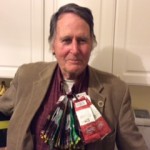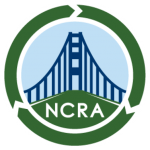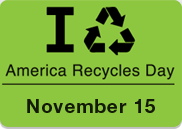Proposed by Portia Sinnott, MS+/NCRA/GRRN/ZWUSA/ZWBT, 1/14/16
In 2015 28 American Recycles Day (ARD) events were listed in California and less than half were in Northern California. I propose NCRA help double the number of California ARD events by promoting participation during Zero Waste Week and at Recycling Update. Read More “America Recycles Day Proposal”
Category: Newsletter
What’s Next ARB?

By Tom Wright, SustainableBizness.com, 1/14/16
Editor’s Note: Arthur Robinson Boone joined NCRA in the summer of 1983 and has been a continuous and active member for 33 years. He served as President in 1987 and again from 2011 -2013 and Secretary for at least 10 years in between. He founded the very popular Recycling Update (RU) in 1995 and managed it well until stepping down in 2013. One of NCRA’s primary teachers, he produces Introduction To Recycling (ITR) two times a year and would like to do a redux of Nature of Materials. He continues as the chair of the Zero Waste Advocacy Committee (ZWAC). In honor of all that Arthur does or has done for NCRA, Tom Wright stepped up to interview him for the NCRA News. Read More “What’s Next ARB?”
Matadors In Recycleland
By Basille Jimenez, 12/10/15, CSUN AS Recycling
My name is Basille Jimenez and I work for California State University of Northridge Associated Students Recycling Coordinator Cyndi Signett. She told me about your interest in our America Recycles Day event, “Matadors in Recycleland,” which we held on November 12, 2015.
Inspired by the classic book Alice in Wonderland, we decided to change the name to benefit our campus; CSUN’s mascot is the Matador. Our goal was to educate and provide information to our campus community about the importance of recycling and living a more sustainable lifestyle as well as the promote clubs and organizations that CSUN partners with to encourage this behavior.
Some of the games we tied into our theme were:
This Way/That Way Speed Sorting – A sorting game where we provided 3 bins – bottles/cans, paper and trash, a pile of mixed materials and the person had to sort out the pile under a time limit.
Croquet – A simple game of croquet but the materials used to create the mallets were reused paper tubes, large plastic bottles and cardboard. Water bottles filled with water were used to ensure the wickets did not topple over.
Scavenger Hunt – Students were given clues that led to a specific tent or person, where they had to answer a question related to sustainability correctly or win a game to receive the next clue.
When planning, we ensured that all games and crafts we created were made of recycled materials collected by our Operations team throughout campus. We also gave away promotional items such as lunch containers and reusable water bottles to encourage students to reuse rather than purchase on campus as well as at home. We also repurposed many materials that we had stored in our basement. For example, Associated Students had surplus plastic cups they purchased for a prior event; rather than to toss them out like many organizations sadly do, we reused them to hand out popcorn and snow cones.
# # #
Donate Food Without Fear of Being Sued
MOORE’S MUSINGS
A semi-monthly feature, exclusive to NCRA News, from NCRA general counsel and board member John Moore, concerning recent legal decisions relating in some manner to Zero Waste.
BE A GOOD SAMARITAN – DONATE FOOD WITHOUT FEAR OF BEING SUED
By John D. Moore, NCRA Vice President and Legal Counsel, Henn, Etzel & Moore, Inc.
Sometimes the fruit gets rotten
And falls on to the ground
There’s a hungry mouth for every peach
As I go ramblin’ ’round boys
As I go ramblin’ ’round — Woody Guthrie
Among the many reasons Woody Guthrie would have heard in the 1930s to justify not providing blemished peaches to the hungry – fear of getting sued was not likely among them, but he would not be surprised to learn that it is an excuse today. The purpose of this article is to present, unambiguously and emphatically, federal law which immunizes from suit everyone who donates food in good faith without actual knowledge that it is harmful. Please clip this article and show it to any prospective donor of food – grocery, caterer, restaurant, farmers market, who expresses reluctance to donate out of fear of being sued:
UNDER FEDERAL LAW (42 U.S.C. Section 1791(c)(1)), THE DONOR (person, entity, gleaner, nonprofit) OF FOOD IN GOOD FAITH IS NOT LIABLE FOR CLAIMS THAT THE FOOD CAUSED HARM.
This law is known as the Good Samaritan Law or more specifically the Bill Emerson Good Samaritan Food Donation Act. The story of the Good Samaritan is of course a nice story from the Bible. Jesus was being quizzed by a lawyer about what Jesus meant by “love thy neighbor”. Jesus described a man who had been attacked by bandits and left for dead on the road. Two priests passed him by without giving aid. A third, from Samaria, stopped, bound the man’s wounds, put him on his own donkey, took him to an inn and paid the innkeeper to look after him. The lawyer, shrewdly catching the drift of the story, said, “He that shewed mercy on him.” Then Jesus said, “Go, and do thou likewise.”
The drafters of the federal Good Samaritan law did not possess the simplicity of the biblical expression and so it has the ifs, ands and buts, common to statutes. In the interest of legal scholarship, I present the operative statutes. The primary statute, 42 U.S.C. Section 1791 (c)(1), says:
“A person or gleaner shall not be subject to civil or criminal liability arising from the nature, age, packaging, or condition of apparently wholesome food or an apparently fit grocery product that the person or gleaner donates in good faith to a nonprofit organization for ultimate distribution to needy individuals.”
Section 1791(c) (2) applies the same protection to nonprofits that receive donated food. Section 1791(b) defines all the terms used in the broadest fashion. For example, Section 1791(b)(4) defines “food” to mean, “ any raw, cooked, processed, or prepared edible substance, ice, beverage, or ingredient used or intended for use in whole or in part for human consumption.” Section 1791(b)(10) defines “person” broadly to include all types of business organizations, thereby covering grocery and produce stores, restaurants, farmers markets, and caterers.
While the statute does not define “good faith”, Section 1791(c)(3) states that the liability shield does not apply only where the donor is guilty of “ gross negligence or intentional misconduct.” Those two terms are defined by Section 1791(b) (7) and (8) to mean:
The term “gross negligence” means voluntary and conscious conduct (including a failure to act) by a person who, at the time of the conduct, knew that the conduct was likely to be harmful to the health or well-being of another person.
The term “intentional misconduct” means conduct by a person with knowledge (at the time of the conduct) that the conduct is harmful to the health or well-being of another person.
Finally, Section 1971(d) applies the same protections to the landowners where gleaning takes place, that is, the persons “who allow(s) the collection or gleaning of donations on (their property)”
California does not have an analogous statute. Since Congress has not stated an intent to be the pre-eminent legislative authority in this area, the state of California, or any local jurisdiction, is free to enact its own legislation expanding, but not reducing, the protections of the federal law.
After all that, if you are confused, please allow me to say it again in a declarative certain fashion:
UNDER FEDERAL LAW (42 U.S.C. Section 1791(c)(1)), THE DONOR (person, entity, gleaner, nonprofit) OF FOOD IN GOOD FAITH IS NOT LIABLE FOR CLAIMS THAT THE FOOD CAUSED HARM.
Boone Is Practicing HABU!
WHAT’S BOONE BEEN DOING? PRACTICING HABU!
By Arthur R. Boone, Center For Recycling Research and Total Recycling Associates
As NCRA’s longest-serving board member, it is my internally-generated task to always adhere to the highest standards of waste avoidance and zero discards to landfills.
This commitment requires near-tortuous attention to details and continuous practice of “highest and best use” [HABU], an almost ritualistic attention to personal discarding practices. As with the Jewish custom of “eating Kosher” that requires knowing the history of anything that you put in your mouth, living a HABU life requires knowing where this small piece of creation will end up when you are finished using it.
I have on my desk now five small items, 1) a rubber band, 2) a pebble, 3) a paper clip, 4) a blue Lego, and 5) a green piece of a plastic bottle cap. It would be feasible to put items 1 and 2 in the green bin, and items 3, 4, and 5 in the mixed recyclables bin as metals and rigid plastics. But practicing HABU means that item 1 goes in my rubber band container for reuse, the pebble goes in the tubes we use to create water courses in newly-planted trees, the paper clip goes in its desk-top container, the Lego gets aggregated with other Legos found on the street for delivery to the East Bay Depot for Creative Reuse, and the plastic chip goes in my special bag of rigids going to a drop off center so as not to get lost in the 9% residue that the curbside program gives itself while allowing me to put plastics in my curbside bin and fails to mention its residue which goes on to the landfill.
HABU’s details are time-consuming, maybe not the best use of my time but seem to be required by the dictates of Zero Waste. Any comments? ARB

